A rare albino squirrel may be living near Yorktown High School.
A local teen sent ARLnow photos of the squirrel, above, taken in the Yorktown neighborhood. The critter has noticeably red eyes, a characteristic of albino squirrels.
Another photo of the squirrel, taken in Greenbrier Park near the high school, was posted earlier this month to the Capital Naturalist Facebook group.
The last white squirrel spotted in Arlington and reported on by ARLnow was back in 2016 near Columbia Pike.
Albino squirrels in particular are exceptionally rare — about 1 in every 100,000 gray squirrel births, according to a post on the Georgia Dept. of Natural Resources website.
“There are two basic types of white squirrels: albino and leucistic. Albinos have pink or blue eyes and no dark pigments anywhere on their bodies,” the post notes. “Squirrels that have white coats and dark eyes are called leucistic.”
“The scarcity of albino squirrels is thought to be at least partially linked to the animal’s lack of any dark eye pigment: This leaves them more susceptible to the harmful effects of sun rays, which can permanently damage their eyes,” the post adds. “In turn, their poor eyesight makes them more likely to suffer injury and death by falling out of trees.”
Alonso Abugattas, Natural Resources Manager for Arlington County and the administrator of the Capital Naturalist group, said there have also been reports of white squirrels in neighboring jurisdictions like McLean and D.C. — on the National Mall — over the past few months.
“Most of these are white squirrels, but not albinos,” Abugattas told ARLnow. “Albinos due to a lack of pigment have pink eyes [and] are indeed very rare as this affects their sight.”
The restoration of Ballston Wetlands Park is officially complete and the park is now open to the public.
Arlington County officials and community members marked the occasion today (Tuesday) with a ribbon-cutting.
The rain-soaked event marked the end of a $4 million renovation project that transformed what was formerly known as Ballston Beaver Pond — until the departure of the beavers — from a sludge-filled area into a natural stormwater filtration system and wildlife refuge.
“Over the years, sediment, trash, and invasive plants essentially filled the pond,” County Board Chair Christian Dorsey told a crowd of attendees. “Now, cleared of that sediment and other debris, this retrofitted wetland system not only improves stormwater flow and filtration but also captures trash, serving as both a wildlife refuge and a natural respite within our urban village of Ballston.”
Initially built in 1980 as a stormwater detention facility for runoff from I-66, the pond gradually evolved into a haven for local wildlife. By the 1990s, species such as beavers, muskrats, geese, herons, egrets, red-winged blackbirds, fish and turtles had migrated to the area.
Dam-building activities by the beavers, however, interfered with the site’s original drainage systems. When the beavers eventually left, the county took the opportunity to make necessary improvements.
Planning for the renovations dates back to 2011 but it took a decade for the work to kick off in December 2021. Acquiring the necessary easements took about eight years and Covid further delayed the project.
The site now features new informative signage, educational exhibits and thousands of native trees and plants. Logs for turtles to sun themselves, dubbed “basking stations,” have also been added.
There is also a hidden feature to manage beaver activity going forward. The county installed a secondary, concealed pathway for water to flow out and bypass their dams, a solution known as a “beaver baffle.”
That may be prescient, given some reported beaver sightings, Lily Whitesell, a stormwater outreach specialist with Arlington’s Dept. of Environmental Services (DES), told ARLnow. Perhaps the beavers moved back to enjoy the upgrades to their old habitat.
Jason Papacosma, a DES wetlands project manager, said the project extends beyond local restoration efforts and contributes to the broader clean-up of Chesapeake Bay.
“This is a project that gives us credit for our obligations to clean up the Chesapeake Bay. And in terms of all the progress we’ve made to date, this project gives us at least 10% of that overall progress,” Papacosma said.
Demetra McBride, bureau chief of the county’s Office of Sustainability and Environmental Management, acknowledged that while the site was not originally an “environmental asset,” it has now become one.
“I realize that this is not a natural asset… But the community, going back as far as 10 years, wanted more. The leadership of Arlington inspired more. And your public servants and their contractors delivered more,” she said during the ceremony.
After essentially going extinct regionally in the early 1990s, wild turkeys are gobbling up the local limelight again.
Due to habitat loss and excessive hunting, turkeys were extirpated, or made regionally extinct, in Virginia by the early 1900s, explains local biologist Merri Collins.
In the mid-1990s, scientists began importing one species, Eastern Wild Turkeys, from other parts of the U.S. to restart the population in the D.C. area. After three decades, the population has returned, not just in Virginia, but across several eastern states and regions — notably in Boston and Staten Island — leading some wildlife experts to call this “one of the largest conservation success stories in American history.”
“Now there are enough turkeys that they are starting to move into urban and suburban areas with suitable woodland and meadow habitats,” says Collins, a Penrose resident earning her doctorate degree at the University of Maryland Urban Nature Lab.
Based on social media posts, Arlingtonians seem to be seeing more turkey around. One was spotted in Penrose within the last week, while others were seen north of Ballston — near the renovated wetland area — to the East Falls Church area in the last two months. A few years back, a turkey was rescued from a Rosslyn construction site.
“Seeing animals around again that were once absent from the landscape means we are doing something right,” she said. “Our green spaces, like parks, are plentiful enough and have healthy enough habitat to support more wildlife diversity.”
Collins uses trail cameras to study turkeys and says anyone who uses these cameras can see large flocks as well as baby turkeys, called poults, and observe their “pretty cool” behaviors.
Not everyone is pleased, however.
“Wild turkeys are a scourge,” wrote one Arlingtonian on Nextdoor. “Do not feed or encourage them. Call the county and see if we can stop them proliferating.”
Other commenters jokingly saw these thoroughly urbanized birds as a potential dinner.
Novelty or nuisance, today, the turkey population in Virginia today numbers 180,000, according to a fact sheet from the Virginia Dept. of Wildlife Resources, which regulates bi-annual hunting seasons for the bird.
“Turkeys in cities sometimes get a bad rep, but also can provide people with some serious laughs,” Collins said, suggesting people to Google “turkeys in cities for some light-hearted reading.”
One turkey, for instance, got a reputation by allegedly attacking a few trail users in Prince George’s County, Maryland. There are other stories of the birds attacking people in Michigan, creating havoc in New Hampshire and, no joke, knocking on doors for food in New York.
To avoid confrontations like that, Collins says, give turkeys the space to “be turkeys.”
“Like with all wildlife, do not chase, approach, or try to touch turkeys,” she said. “If you want to take photos, great! Do it from a distance.”
They do provide some benefits to people, too, because they eat pesky insects and spread the seeds of native plants.
While she has a soft spot for turkeys, Collins notes that D.C. and its surrounding suburbs are home to other interesting animals, including red foxes, coyotes, mink, river otters, owls, hawks, several species of turtles and lizards.
“You may not see them, as many species tend to move around at night, but they are here,” she said.
“You can make your own property friendly to wildlife by planting native plants,” Collins added. “There are a ton of online resources to help people do this and have wildlife friendly yards in cities.”
Vernon Miles contributed a pun to this report
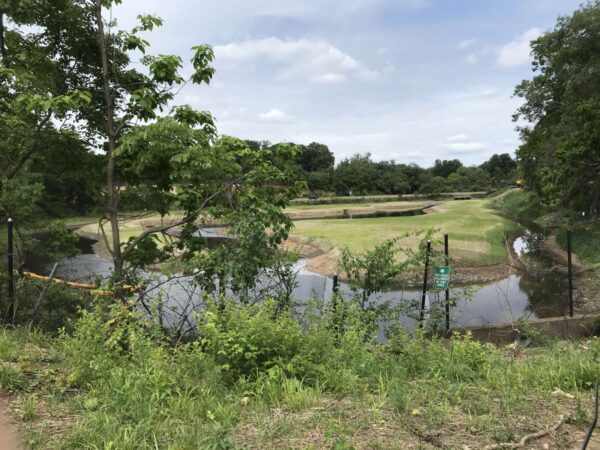
The Ballston Beaver Pond might become Ballston Wetland Park, a more befitting name since the beavers have moved on.
The human-made pond, originally built to collect stormwater runoff and trash from I-66, is undergoing a $4 million renovation. With that makeover and the fact that the beavers have taken their dam-building skills elsewhere, the pond and park are set to get a new name.
Earlier this year, residents were given the opportunity to recommend a new name for the park.
In July, four finalists were revealed:
- Ballston Wetlands, as a way to highlight the wetland feature.
- Crossroads Wetland Park, to recognize nearby Ball’s Crossroads, which was one of the more populated areas in the county in the mid-19th century and the inspiration for Ballston’s name
- Thaddeus Lowe Park, to honor the Union Army’s Chief Aeronaut who performed aerial reconnaissance from his hot air balloon near this location.
- Wetlands Vista Park, because of the natural feature and the new vista platform that’s being built at the park.
Last week, Arlington’s Historical Affairs and Landmark Review Board (HALRB) voted to move forward on a slight variation of the top vote-getter — “Ballston Wetland Park.”
“As the County was renovating the pond to be more of a destination for nature lovers and to better support its important wetland function, it seemed appropriate to update its name,” Department of Parks and Recreation spokesperson Susan Kalish told ARLnow. “While the area does not have beavers, which generally migrate from pond to pond, it is a wetland and it is in Ballston.”
The Neighborhood Conservation Advisory Committee is planning to vote on the proposed name either next month or October. Then, it will go to the Parks and Recreation Commission later in the fall. If the recommended new name passes both bodies, it will then head to the County Board for a vote likely in October or November.
The reason for the change is that the beavers have gone bye-bye.
The pond was originally built back in 1980 to collect stormwater runoff from I-66. However, in the 1990s, and to the surprise of county officials, beavers started moving in — along with other wildlife like muskrats, geese, heron, egrets, redwing blackbirds, fish, and turtles.
The beavers proceeded to do what they do best, which is building dams and messing up drainage systems. The dams compromised water quality, prevented certain vegetation from growing, and essentially defeated the park’s purpose of being for stormwater runoff.
However, the beavers have since moved on.
The county began planning renovations back in 2011, but it took eight years to acquire all the easements. Then, right when construction and draining were about to start, the pandemic delayed the project again. Finally, in December 2021, work began on renovating the pond and park.
As part of that work, the county is installing beaver baffles as a means of keeping the busy mammals out.
The county is also adding updated trash control devices, turtle basking stations, interpretive signs, and a new boardwalk on the eastern side of the pond.
With work ongoing, the bike trail on the east side is currently closed. A temporary detour is in place along the south side of the pond, that connects Washington Blvd to the Custis Trail.
The work is expected to wrap up next summer.
The young, mangy Fairlington fox that’s roaming around Fairlington and the efforts to trap it has become an object of fascination on local social networks.
The saga started over the past week or so when several community members started spotting a sickly, young fox wandering around streets and in between houses. Appearing on the verge of being hairless, it was clear that the fox had mange — a potentially fatal skin disease that causes loss of fur and is caused by microscope mites.
Beyond impacting foxes, mange is also dangerous to household pets and can cause severe itching in humans as well. The disease can potentially be resolved with medication, however.
Karen Dadey, Fairlington resident and a retired major in the U.S. Army, sprung into action. She contacted the Animal Welfare League of Arlington (AWLA) and, then, proceeded to set up a trap herself in hopes of getting the fox to a wildlife rehabber as quickly as possible.
Dadey put a camera near the trap as well, baited it with a 7-Eleven cherry pie — at the advice of an expert, she said — and posted daily videos onto Nextdoor and the popular “Fairlington Appreciation Society” Facebook group in hopes of encouraging others to help.
Dadey admitted to ARLnow that this was her first time doing something of this nature, but felt like something needed to be done quickly.
“I’m just leaning in as a private citizen, trying to do the right thing for my neighborhood, to keep our pets safe and our wildlife safe,” she told ARLnow.
She ended up getting three other volunteers to help monitor the trap, replacing the bait and water bowl, and releasing any other animals that may have inadvertently wandered in. That included several squirrels and a neighborhood cat.
While many applauded her efforts in the comments, some argued that “capturing a wild animal is a really bad idea, not to mention illegal.” They urged her to “leave this to the professionals.” Those exhortations have been met from strong pushback from supporters of the amateur effort to save the fox.
Dadey called those positing critical comments “bullies.”
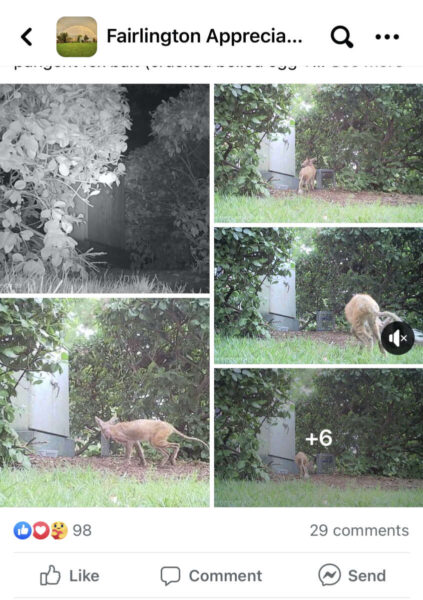
Both Dadey and her critics, however, seem to approve of what happened next. Within days, the professionals at AWLA got wind of what was happening and replaced Dadey’s trap with one of theirs.
Chief of Animal Control Jennifer Toussaint posted on the neighborhood Facebook group, providing background on fox behaviors and advising against handling, interacting, or feeding the animals. She also cautioned that helping a fox with mange can be very challenging.
“For the young fox in the photos we want to be up front and honest with the public. Finding rehabbers willing to take a yearling fox with mange is near impossible,” Toussaint wrote in the post. “This illness is highly transmissible to other animals they have in care and they most commonly recommend humane euthanasia.”
Dadey said that at least one of these issues has been resolved, having already arranged with the Nirvana Ridge Wildlife Refuge near Culpepper, Virginia to take the young fox and nurse it back to health.
In the days since, though, the fox still hasn’t been caught.
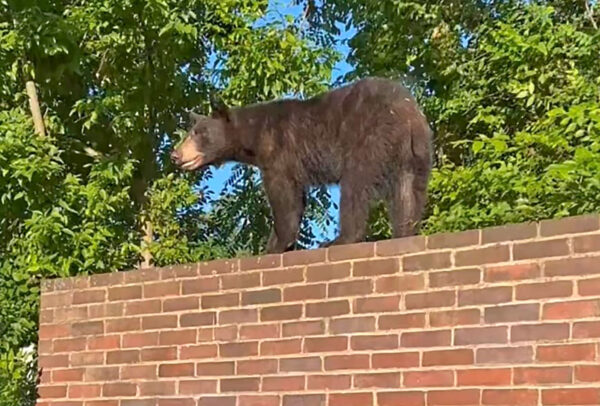
A bear was spotted walking around an Arlington neighborhood this morning, prompting a warning from animal control.
The Animal Welfare League of Arlington said it confirmed a resident’s report of a young black bear roaming around, “likely… in his search for a new home habitat.”
“While bear sightings are rare in Arlington County, they are not unheard of,” AWLA said. “Unfortunately in past bear sightings, we have had issues with members of the public going out in search of the bear to take their own photos or see it for themselves. This is VERY dangerous.”
Residents who see the bear are asked to “call AWLA immediately” at 703-931-9241 and advised to keep a safe distance or get inside.
Patch reported earlier that the bear “was spotted in Arlington’s Maywood community Monday morning, walking through people’s yards and onto porches as it headed to a park on the east side of the neighborhood near the Custis Trail.”
Just over two years ago a black bear was seen walking around near Bishop O’Connell High School in Arlington. Animal control officers were unable to locate the bear after the initial sighting.
More from AWLA, below, on the latest bear incident.
On June 5th, 2022, a young black bear was spotted by a member of the public in Arlington County. Our Animal Control Officers confirmed the sighting and immediately contacted the Virginia Department of Wildlife Resources (DWR) and Virginia State biologist. The bear seems healthy and is likely a male yearling moving through Arlington Co in his search for a new home habitat. We are continuing to update these agencies as the location of the bear changes.
While bear sightings are rare in Arlington County, they are not unheard of. Unfortunately in past bear sightings, we have had issues with members of the public going out in search of the bear to take their own photos or see it for themselves. This is VERY dangerous, and can cause harm to you, others, and the bear. Instead, we ask that residents call AWLA immediately at (703) 931-9241 if they spot the bear, and keep to a safe distance or indoors.
We also urge residents follow these recommendations from DWR:
- Secure garbage: Keep in a locked shed or inside until collected or use a bear resistant container.
- Secure any compost piles
- Take down bird feeders.
- Secure pet food in bear-resistant containers or inside locked sheds.
- Clean up porches/decks: Clean grills including drip pans, remove any potential food sources, and remember a screened in porch is not a “secure” storage area from a bear’s point of view.
- Never leave food, trash, or pet food inside your vehicle.
- Keep dogs on a leash at all times
Thank you for helping us keep people and wildlife safe in Arlington!
View this post on Instagram
Ballston Beaver Pond is in need of a new name because, well, there are no more beavers.
An online survey to rename Ballston Beaver Pond is set to close on Wednesday, June 1, as renovations at the pond are on hold due to a delay in material delivery.
Residents are asked to suggest names for the pond that either “reflect a park’s unique character and features” or one that “honors someone who made a significant and positive impact to Arlington County,” the survey says. Prior to the renovation, the pond was home to a variety of wildlife, including beavers. But the county is installing beaver baffles to discourage them from returning and building dams again.
The survey says residents will also be able to weigh in on a list of potential park names, compiled at least in part from the survey, in June. Aileen Winquist, the communication manager for the renovation project, said the final name is set to be presented to the Arlington County Board in September.
Renovations at the Ballston pond, which include converting it from a dry pond to a wetland, are paused because of a delay in the delivery of a concrete block that will be installed in the upper part of the pond, according to the project’s website. Winquist said the block is expected to arrive in mid-June.
“That’s kind of the last grading work that will need to be done,” she said. Much of the excavation and grading work was completed in April.
“The contractor has made excellent progress so far and the project is on schedule,” she said. The renovations are expected to wrap up in July 2023.
After installing the concrete block, which Winquist said would be a settling area for sediment and trash from water coming into the pond, renovations will continue with building viewing platforms and planting vegetation.
“The remaining work will be to install the platform — there’s a viewing platform on the east side of the pond — and then to do all the planting,” she said, adding “thousands of plants will be planted in the pond.”
The renovation process faced a series of interruptions before it began in December 2021. The project was planned, but in a holding pattern, between 2013 and 2019. It went into hiatus soon after the redesigned project went public in 2019 due to “COVID-19 and related budget concerns,” according to a county report in June 2021.
The current renovation project is a “high-priority project” in the county’s Stormwater Management Program and “contributes to restoring the Chesapeake Bay,” according to the project’s website.
Other renovation measures listed include constructing turtle basking stations and other wildlife components, planting wetland vegetation, and removing invasive species. The design plan for the project also includes spaces for a shrub wetland and a marsh.
The pond was initially built as a dry pond, which she said meant stormwater runoff from I-66 would temporarily sit in the pond area. That changed after the beavers arrived and built their dams. The renovations, meanwhile, aim to convert the pond into a wetland.
“The pond will have a lot of flow channels for the water to flow through, and as it’s filtered through the wetland plants and soils, that will remove pollutants from the stormwater runoff,” Winquist said.

Fish Kill in Four Mile Run Last Week — “Anyone visiting lower Four Mile Run in the last several days should have noticed many dead fish, large and small, along the streambank and floating out in the water, the result of a pollution incident that occurred some time Thursday, May 12.” [Four Mile Run Conservatory Foundation]
Rumor: Board Members May Not Run Again — “My spies in the Arlington Democratic infrastructure say odds favor neither County Board member up for election in 2023 actually running for a third term. And if Katie Cristol and Christian Dorsey do skedaddle (and just as they’d start earning some bigger bucks …), the field would seem to be wide open.” [Sun Gazette]
More Big Changes at DCA — “Reagan National Airport is about to go through a massive rebranding. Because of recent expansions, the airport will be split into Terminal 1 and Terminal 2. Terminal 1 will be the original airport building housing the A gates. Terminal 2 will house the newly named B, C, D and E gates. More than 1,000 signs in and around the airport will be changed starting June 4.” [NBC 4]
Arlington Apartment Buildings Bought — “Cortland, one of the largest apartment owners in the U.S., is making a huge entrance to Greater Washington, acquiring four Arlington multifamily properties in an expected $1B investment. The Atlanta-based investment firm acquired a newly developed 23-story, 331-unit apartment building in Rosslyn and a 534-unit building in Pentagon City, Cortland announced Wednesday.” [Bisnow, Washington Business Journal]
County Honors Trees, Volunteers — “Mother Nature is smiling! Arlington County recognized five individuals who volunteer at Bon Air Park as recipients of the 2021 Bill Thomas Park Volunteer Award and highlighted its 2022 Notable Trees — both which honor the people and natural resources that preserve Arlington’s green spaces — during the Arlington County Board’s recessed meeting on May 17.” [Arlington County]
Wawa Coming to Falls Church — “Philadelphia-area convenience store chain Wawa is under contract to ground-lease the shuttered Stratford Motor Lodge site in the city of Falls Church, which it will replace with a roughly 6,000-square-foot store — but no gas pumps… The motor lodge closed last fall, the Falls Church News Press reported.” [Washington Business Journal]
Four Mile Run Dredging Approaching — “Alexandria and Arlington will start clearing debris and dredging Four Mile Run in September, and the project will close sections of [an Alexandria] park from the public for four to six months. The City and County maintain a shared flood-control channel in the lower portion of the nine-mile-long stream, and have partnered to dredge Four Mile Run since 1974.” [ALXnow]
It’s Thursday — Rain early in the morning, then clearing later in the day. High of 82 and low of 61. Sunrise at 5:54 am and sunset at 8:19 pm. [Weather.gov]
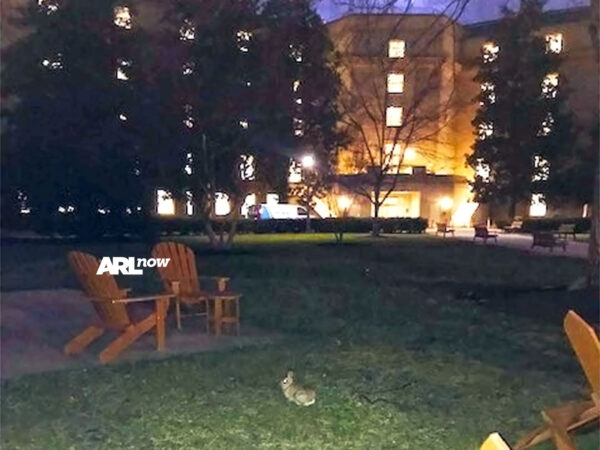
If you thought the Pentagon chicken was impressive, wait until you hear about the Pentagon courtyard bunny.
In what might be the world’s fluffiest and most adorable infiltration of a secure military installation, a bunny was recently spotted hopping around in the 5.1 acre outdoor courtyard at the center of the headquarters of the U.S. Dept. of Defense, ARLnow has learned.
There is no official confirmation of the bunny’s existence — the DoD said it does not keep tabs on small, harmless animals in the courtyard — but we have obtained photographic evidence, above, and an eyewitness account.
“I just wanted to highlight that while the Pentagon Chicken is receiving its 15 minutes of fame, the Pentagon Bunny actually successfully infiltrated the Pentagon,” a tipster tells ARLnow. “It is currently living peacefully somewhere in the Pentagon’s courtyard, a location that is likely the most heavily guarded rabbit burrow on the planet… that is until the restaurant in the Courtyard decides to have an extremely locally sourced courtyard-to-table special.”
Given that it is outdoors and has plenty of trees and people eating meals, the courtyard is naturally a hangout spot for birds, which can simply fly in. It’s unclear how a bunny would have hopped into a place surrounded by five rings of some of the most secure office space on earth, though there are some theories.
“Aside from birds I have not seen any other wildlife. That is why I thought the rabbit was so notable,” the tipster said. “A bunch of us were trying to figure out how the rabbit made it into the courtyard since there are no obvious points of entry. The current hypothesis is that the bunny was carried into the courtyard by the hawks that were nesting in one of the trees and dropped before it was fed to the offspring.”

A Pentagon spokesperson sent an appropriately non-specific response to ARLnow’s inquiry about the small mammal that’s apparently living inside the courtyard’s five walls.
“From time to time there may be various species of animals on the reservation that make it to the Center Courtyard,” said Sue Gough, Department of Defense spokesperson. “We normally do not intervene unless the animals create a hazard to building occupants, or the animal is at risk from our activities. In those situations, we will try to have it leave on its own accord, or capture it and release it to the environment where it is distanced from our activities (e.g., land adjacent to Boundary Channel).”
Pressed about this particular bunny, the official word from the DoD — which is a bit busy at the moment — is that they’re not sure.
“We don’t track individual wildlife unless there is a safety hazard to building occupants or the animal,” Gough said.
The Pentagon chicken, on the other hand, attracted national media attention after the Animal Welfare League of Arlington revealed that it had taken custody of the rogue poultry at the request of the DoD, after it was found wandering around a secure area outside of the building.
The chicken went viral on social media, now has its own t-shirt line, and even earned a Jimmy Fallon-sung ballad on the Tonight Show.
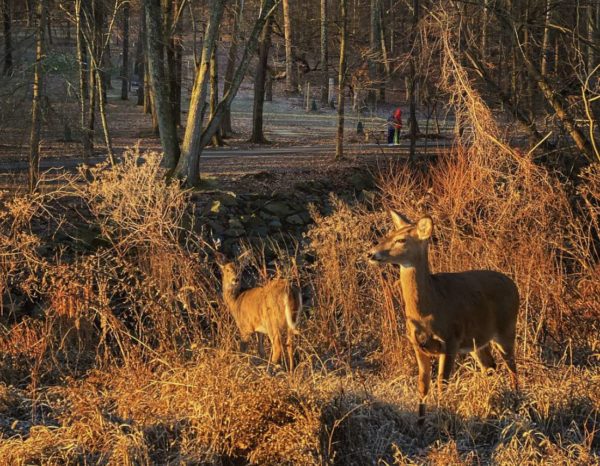
The Animal Welfare League of Arlington is bucking the results of a study suggesting the county has a deer problem.
Arlington County hired a consultant last spring to count the local deer population using drones. The company published a report in September saying that parts of Arlington had populations of 20-39 deer per square mile in certain places, exceeding what’s considered healthy (between 5 and 15 deer per square mile).
In a statement released Monday, AWLA, which oversees animal control for Arlington County, disputed the idea that the local deer population reaches unhealthy levels and urged the county to adopt a “practical, humane, and sustainable deer management plan” that doesn’t place too much focus on the numbers.
“From our extensive work in humane wildlife management, we know from experience that the issue is not the number of deer but rather the conflicts we have with them,” AWLA President & CEO Samuel Wolbert and Chief of Animal Control Jennifer Toussaint said.
The joint statement comes as county staff prepare to incorporate this data into a broader look at what steps Arlington needs to take, if any, to maintain a healthy white-tailed deer population.
Wolbert and Toussaint say there’s “scientific basis” for the claim that 5-15 deer per square mile is healthy, arguing no single count of deer qualifies as over-population.
“The fact is, determining a ‘healthy carrying capacity’ is a political judgement that is not rooted in biology: some communities, and even areas within a community, will be able to sustain different numbers of deer based on multiple factors, like type and quality of food and cover,” they said. “There is no one ‘magic’ number that any community should have. Saying Arlington County, with 13 deer per square mile, has too many deer is a political determination and not based on the environment in which the deer are located.”
AWLA leaders say complaints about deer may have precipitated this survey, but of all the calls and online reports their animal control division receives related to wildlife, relatively few involve deer.
Since November 2020, when it launched an online reporting system, AWLA has received over 650 wildlife concerns, and of those, 17 (3%) related to deer. Meanwhile, in 2021, 131 calls of the 2,733 calls for service related to wildlife (or 5%) were deer-related — and the most common concern was about the health of orphaned fawns.
“If there truly were ‘too many deer’ we, as the County’s wildlife experts, would have more deer-related complaints or issues arising from deer — which is simply not the case,” Wolbert and Toussaint said.
As for the argument that deer contribute to the destruction of the forest understory, cited in the report, AWLA leaders argue that deers are unfairly blamed for the impacts of other factors.
“It’s easy to blame deer for any forestry growth woes, when the reality is that forests are affected by many factors: insect damage, disease, pollutants (like harsh fertilizers), invasive species, increased foot traffic, climate and weather extremes, over-development… and deer,” Wolbert and Toussaint write.
In response, Arlington County Department of Parks and Recreation said the survey was just the first step in determining whether Arlington needs to more actively manage deer. Next, the county will hire a professional wildlife consultant to interpret this data and gather additional information to determine if and how deer are impacting the natural landscape, said DPR spokeswoman Susan Kalish.
All this information will guide a public engagement process that will culminate with a presentation to the County Board this summer.
“Deer are necessary aspects of wildlife with important ecological functions when in balance with the surrounding habitat,” Kalish said. “Arlington takes its role as a steward of wildlife and its natural lands seriously.”
Arlington County recently funded a deer survey to establish a count of our white-tailed deer population. The results of this survey suggest that Arlington County has a “deer problem”…but we disagree. Read our President & Chief ACO's statement here: https://t.co/eFH9tuSHOc pic.twitter.com/0F4W3i7SL1
— AWLArlington, VA (@AWLAArlington) February 7, 2022

A black coyote was sighted near Lubber Run this week, and she may have pups.
While sighting the shy canine is relatively rare, the dark fur of the Arlington Forest coyote is a touch more uncommon. Its coloration is what helped the Animal Welfare League of Arlington identify she was not new to the area.
One Arlington Forest resident called the AWLA, which runs the county’s animal control operation, to report a sighting on Monday, and said the coyote had pups in tow, although officers couldn’t locate her or the young to confirm. On Tuesday, an ARLnow reader Amy Cocuzza caught her on camera in the neighborhood.
Cocuzza reached out to a USDA wildlife specialist, who said the Arlington Forest coyote’s dark fur is uncommon but not rare. Coyotes in the East have tremendous color variation.
AWLA’s Chief of Animal Control Jennifer Toussaint tells ARLnow the Arlington Forest coyote is not the only dark coyote she’s seen in Arlington. She saw her first on Route 110 near Memorial in 2013. She compared the uncommon coloration — known as melanism — to that of the more prevalent black squirrel.
She said the coyote Cocuzza saw is likely female and they became aware of her in Arlington Forest last year.
Previous coyote sightings reported by ARLnow were all of a grey or lighter brown colored canine. A coyote was spotted multiple times wandering around in the Fairlington area in 2020. Coyotes have also been seen moseying along Washington Blvd, and in Potomac Overlook Regional Park, Lubber Run and Cherrydale. In 2014, a coyote was struck by a car near Arlington National Cemetery.
Toussaint called coyotes “highly adaptable opportunists” and said they thrive living near people in suburban and urban settings like Arlington where scavenging for food is easy — taking advantage of pet food or trash left out. But she said the presence of a coyote, which can be active both day and night, isn’t cause for alarm. In fact, there are some benefits like free rodent control.
“Urban coyotes are born right in our neighborhoods and are generally familiar with us, our pets, and our routines,” she said. “Occasionally, a curious coyote may need to be reminded to be wary of people, especially if someone has been feeding them, which is not advised or legal.”
Toussaint recommends “hazing” techniques, such as clapping your hands, raising your voice, blowing a whistle or shaking an aluminum can with pennies inside. She said, while coyotes don’t pose a risk to humans, they should never be handled and pets should be monitored closely and kept current on rabies vaccines.
“We don’t see many interactions or conflicts between coyotes and people or pets, but when we do, it’s usually because someone was startled, so it’s a good idea to practice hazing techniques before allowing a pet in your yard, as well,” she said.
Arlington’s Natural Resource Manager Alonso Abugattas writes that “the Eastern coyote is bigger than those in the West, about the size of a border collie or even German Shepherd, often between 45 to 55lbs” with males usually larger than the females.
The USDA specialist suggested to Cocuzza that the black coyote may be wandering out because it’s their mating season, and “they do tend to be more bold and wander out at this time.”
Hat tip to Amy Cocuzza

